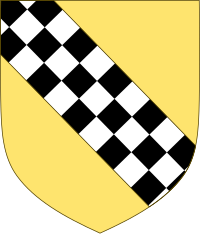John de Menteith
This articleneeds additional citations forverification.(December 2018) |
John de Mentieth | |
|---|---|
 | |
| Personal details | |
| Born | c.1274 |
| Died | c.1329 |
Sir John Menteith of Ruskie and Knapdale(c. 1275 – c. 1329) was aScottishnobleman during theWars of Scottish Independence.He is known for his capture of SirWilliam Wallacein 1305 and later joined with KingRobert I of Scotlandand received large land grants inKnapdaleandKintyrefor his service. He is described as "guardian" of theEarldom of Menteith,as his great-nephewAlan II, Earl of Menteithwas a minor at the time of the death ofAlan I, Earl of Menteith.
Life[edit]
John was the younger son ofWalter Bailloch Stewart,andMary I, Countess of Menteith,the daughter ofMuireadhach II,Earl of Menteith.[1]John possessed the land ofRuskieinStirlingshire.John was a party to theTurnberry Bondwith his father, Walter Stewart and theBruces,which was signed atTurnberry Castleon 20 September 1286.
With his older brotherAlexander,John was involved in the resistance against KingEdward I of Englandand were both captured after theBattle of Dunbaron 27 April 1296. While Alexander was released after swearing fealty, John remained a prisoner atNottingham Castlein England until August 1297, when Edward released John from prison, on his taking oath and giving security to serve with the king in the campaign of 1297 in Flanders.

He was appointed the Constable of Lennox and was ravaging the lands ofEdward's partisans in Lennox in 1301. John was sent in 1303 to treat of peace with the English, but refrained from pressing his mission. By 1303 John submitted and had been restored to Edward's favour, for on 20 March 1304 John was appointed Warden of the castle, town, andsheriffdomofDumbarton.Edward was keen to secure the fortification as a major access route into Scotland by sea.
Assheriff of Dumbarton,in August 1305 John is alleged to have conspired withAymer de Valence, 2nd Earl of PembrokeandRobert Clifford, 1st Baron Clifford,at the Parish Church inRuthergleninLanarkshire,to capture SirWilliam Wallaceand have him handed over to the Captain of Scotland, below the Forth,John Segrave, 2nd Baron Segrave.[2][3][4][5]A service for which he was to be rewarded with land, and titles.[3]For this John was labelled traitorous and was given the contemporary nicknameFause Menteith( "Menteith the treacherous, false" ).

Wyntoun,whoseMetrical Chroniclewas written in 1418, says:
Schyre Jhon of Menteith in tha days
Tuk in Glasgow William Walays;
And sent hym until Ingland sune,
There was he quartayrd and undone.
The English chroniclerPiers Langtoftstates that Menteith discovered the retreat of Wallace through the treacherous information ofJack Short,Wallace's servant, and that he came under cover of night and seized him in bed. A passage in theScalachronica,quoted byJohn Leland,notes, "William Walleys was taken of the Counte of Menteith, about Glasgow, and sent to KingEdward,and after was hanged, drawn, and quartered at London. "
Menteith was nominated one of the representatives of the Scots barons in the parliament of both nations which assembled atLondonin September 1305 and was chosen upon the Scottish council, which was appointed to assistJohn of Brittany,the newGuardian of Scotland,in the English interest. John received on 1 June 1306 fromEdwardtheEarldom of Lennox,while on 15 June he received the Warden of the castle, town, andsheriffdom of Dumbartonoffice for life. John returned to Scotland in October.[3]
Edward appealed to John in December 1307 to join him in resisting the revoltingRobert de Brus,however John abandoned hisearldom of Lennox, joining Brus's side. KingRobert I of Scotlandrewarded John with large grants inKnapdaleandKintyre.In March 1308, John was among the Scottish magnates who wrote to the KingPhilip IV of Franceon behalf of the nation and in 1309, he was sent with Sir Nigel Campbell to treat withRichard de Burgh, Earl of Ulster,receiving a safe-conduct on 21 August, from KingEdward II of England.John's English lands were forfeited for his treason. In 1316 he was commissioned withThomas Randolph, Earl of Morayto treat on behalf of Robert Brus for a truce with the English. John remained closely attached to the royal court, as is shown by the numerous charters he attested and was at theArbroath parliamentin April 1320, and signed theDeclaration of Arbroathsent by the barons of Scotland toPope John XXII.
John was one of the negotiators of the thirteen years' truce between Bruce and the English, signed on 30 May 1323 and was present at a Scottish council atBerwickin June. The last recorded grants to him are in 1329, during the minority of KingDavid II of Scotland.
Issue[edit]
Menteith, by an unknown spouse, had issue:[6]
- Sir John de Menteith the younger, married Helen daughter ofGartnait, Earl of Mar
- Walter Menteith
- Johanna Menteith, married (1)Malise, 7th Earl of Strathearn,(2)John Campbell, Earl of Atholl,(3)Maurice de Moravia, Earl of Strathearn,(4)William de Moravia, 5th Earl of Sutherland
Notes[edit]
- ^Douglas, Peerage of Scotland, p. 472, ed. 1764
- ^"William Wallace betrayal spot in Rutherglen to be marked".scotsman.22 January 2016.Retrieved8 May2021.
- ^abcTout, Thomas(1894)..Dictionary of National Biography.Vol. 37. pp. 255–257.
- ^"The Historical Background to the Site of Rutherglen Old Parish Church".Rutherglen Old Parish Church.
- ^Scottish nationalist group hold Lanarkshire event to remember betrayal of William Wallace,Jonathan Geddes, Daily Record, 9 August 2022
- ^Balfour Paul vol vi, pp 132-133
References[edit]
![]() This article incorporates text from a publication now in thepublic domain:Tout, Thomas(1894). "Menteith, John de".Dictionary of National Biography.Vol. 37. pp. 255–257.
This article incorporates text from a publication now in thepublic domain:Tout, Thomas(1894). "Menteith, John de".Dictionary of National Biography.Vol. 37. pp. 255–257.
- Paul, James Balfour,The Scots Peerage,Vol. VI, (Edinburgh, 1909)
